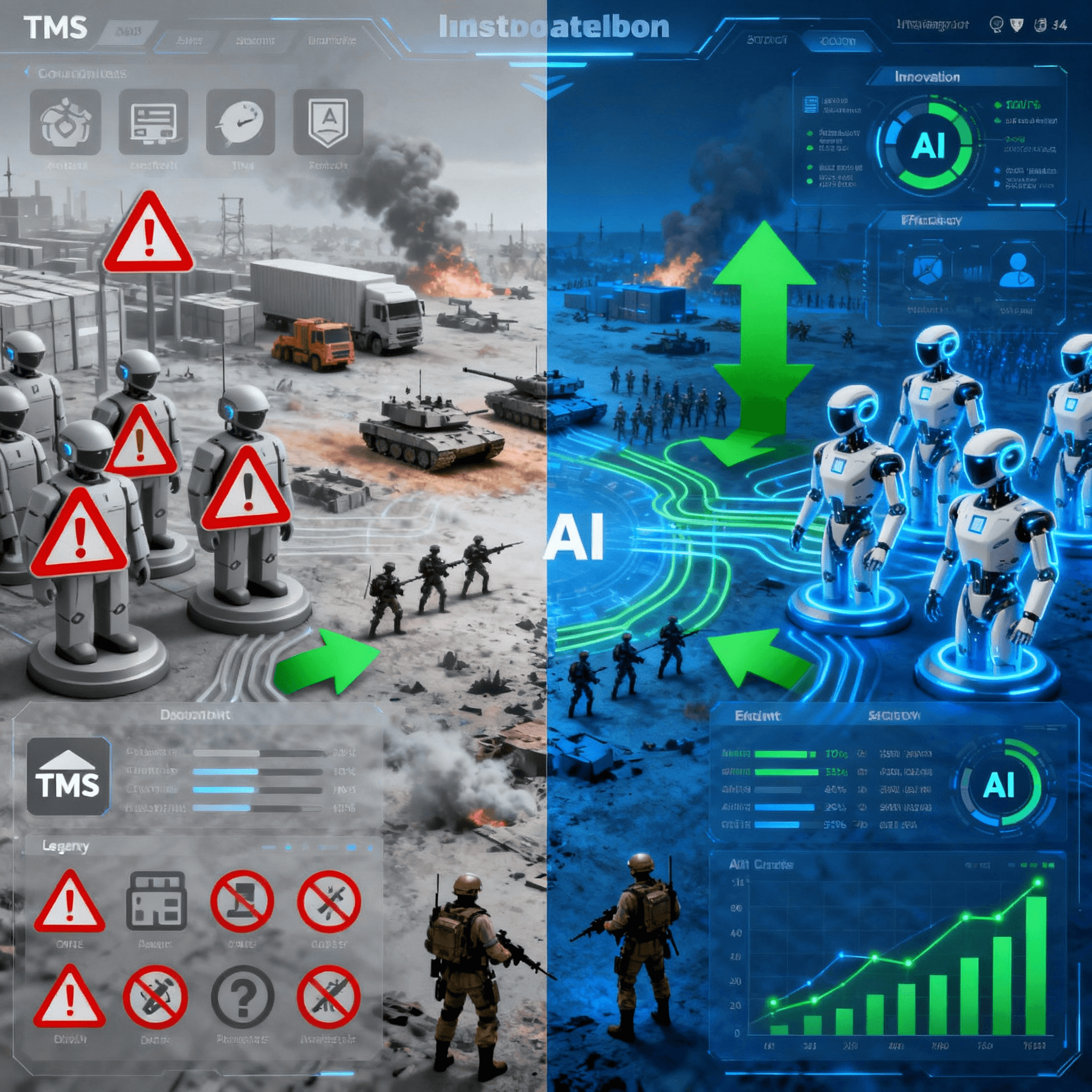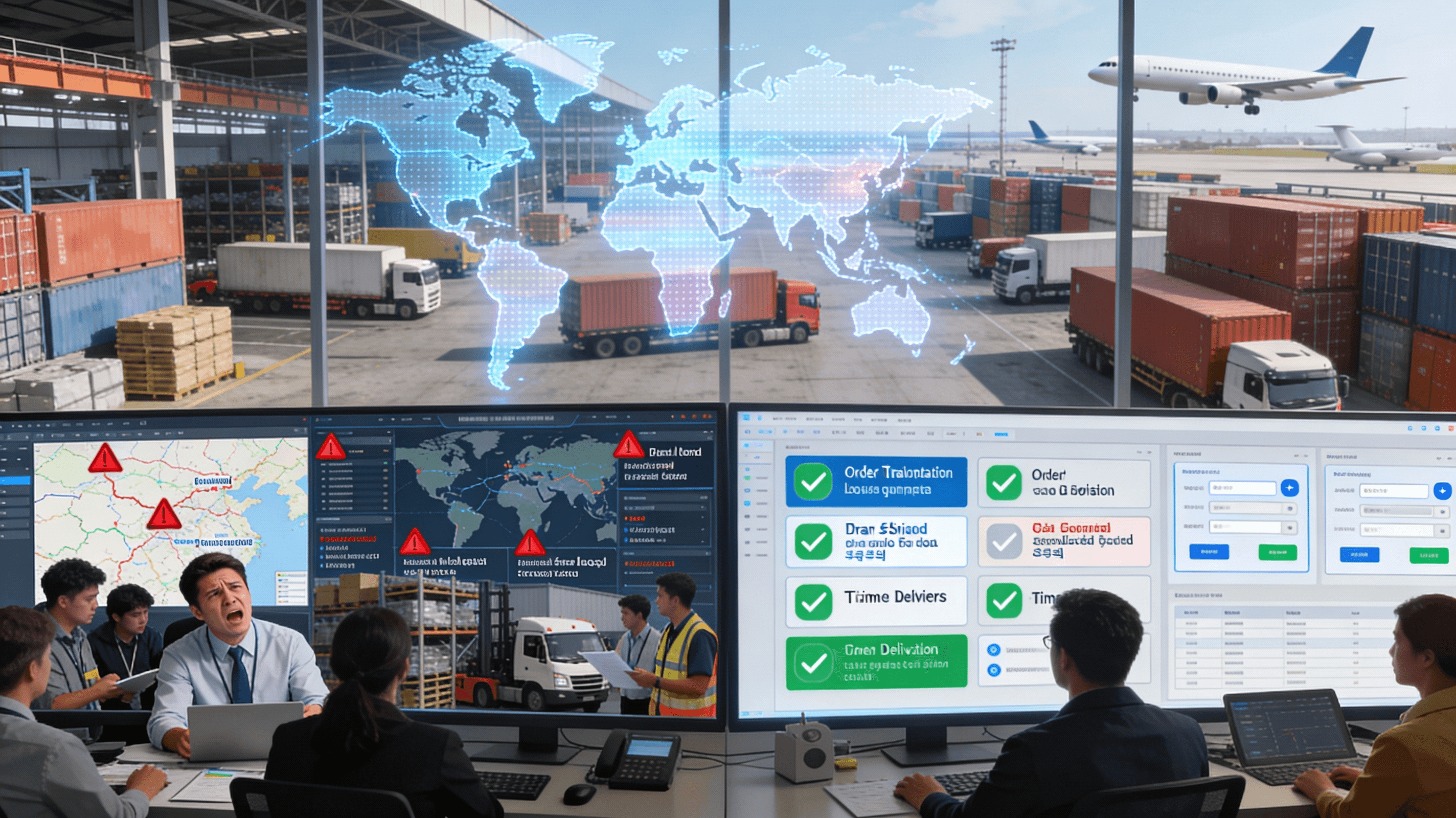AI Agents vs Legacy TMS: Performance Comparison in Logistics 2025
Tuesday, 21 Oct 2025
|
AI Agent Capabilities vs. Legacy TMS: The New Competitive Battleground in Logistics
Introduction: Why AI Agents Are Outpacing Legacy TMS
In the logistics arena, AI agents are emerging as superior alternatives to legacy Transportation Management Systems (TMS), delivering up to 40% greater efficiency in route optimization and real-time decision-making. Traditional TMS, built on rigid, rule-based architectures, struggle with dynamic supply chains, while autonomous AI agents adapt proactively, reducing costs by 20-30% and accelerating operations through predictive analytics and seamless integration. For logistics executives—CEOs, CXOs, and COOs—this head-to-head battle underscores the need to evolve beyond outdated systems to maintain competitive edge in a market projected to reach $2.8 trillion by 2028.
This in-depth comparison dissects the core differences, performance benchmarks, and strategic shifts required, drawing on industry data from McKinsey, Gartner, and real-world implementations. By examining key capabilities—from planning and execution to compliance and scalability—logistics leaders can assess how AI agents transform TMS from static tools into intelligent, self-optimizing ecosystems. The result? Not just survival, but dominance in an AI-driven future where agility equals profitability.
Understanding Legacy TMS: The Foundations and Limitations
Legacy TMS platforms, dominant since the 1990s, were designed for structured, predictable environments, focusing on basic functions like shipment tracking, carrier selection, and invoice auditing. These systems excel in standardized workflows, providing centralized visibility into transportation data and automating routine reporting through ERP integrations. However, they rely heavily on manual inputs and predefined rules, limiting adaptability in volatile conditions like supply chain disruptions or fluctuating demand.
Key strengths include robust compliance features for regulatory adherence, such as automated tariff calculations and documentation generation, which ensure basic operational reliability. Yet, limitations abound: legacy TMS often features archaic user interfaces requiring extensive training, siloed data that hinders real-time insights, and scalability issues during peak seasons, leading to 15-25% higher error rates in manual processes. For instance, during 2024's global port congestions, traditional TMS users reported 30% delays due to reactive rerouting, underscoring their inability to foresee or automate responses.
In essence, legacy TMS serves as a reliable backend for mid-sized operations but falters in modern, data-rich ecosystems where speed and foresight are paramount. As e-commerce volumes surge 25% annually, these systems' rigidity translates to lost revenue opportunities and inflated costs. Executives must recognize that while legacy TMS provides foundational stability, it increasingly acts as a bottleneck, constraining growth in an era demanding hyper-agility.
The Rise of AI Agents: Autonomous Intelligence in Logistics
AI agents represent a paradigm shift, functioning as proactive, goal-oriented software entities that learn from data, make autonomous decisions, and orchestrate multi-system interactions without human oversight. Unlike legacy TMS, these agents leverage machine learning, natural language processing, and reinforcement algorithms to process vast datasets from IoT sensors, weather APIs, and market signals in real-time. Core capabilities include predictive forecasting—anticipating disruptions 7-14 days ahead—and self-healing mechanisms that automatically adjust routes or inventory.
For example, AI agents integrate seamlessly with TMS, WMS, and ERP via APIs, enabling end-to-end orchestration across procurement, execution, and settlement. They excel in anomaly detection, flagging fraud or delays with 95% accuracy, and dynamic pricing, capturing 10-15% more margin during surges. In cross-border logistics, agents handle compliance autonomously, reducing customs delays by 50% through automated documentation and tariff classification.
The true power lies in adaptability: AI agents evolve via continuous learning, improving performance by 20% quarterly, and support multi-modal transport by coordinating sea, air, and road seamlessly. This autonomy frees executives from micromanagement, allowing focus on strategic growth in a sector where 67% of leaders predict full AI dominance by 2028. As logistics complexity escalates, AI agents not only replace but elevate TMS functions, turning reactive processes into predictive powerhouses that drive sustainable competitive advantages.
Head-to-Head Comparison: Core Capabilities Breakdown
Breaking down the comparison across essential capabilities reveals AI agents' decisive edge over legacy TMS, based on 2025 benchmarks from Deloitte and BCG surveys of over 400 logistics firms. In route optimization, legacy TMS depends on manual or rule-based planning, often resulting in 20-30% suboptimal routes due to static algorithms that fail to account for live variables like traffic or weather. AI agents, however, provide real-time adjustments using integrated GPS, weather, and traffic data, achieving 35% fuel savings and more efficient paths through machine learning-driven predictions. This gap translates to a 40% overall efficiency boost for AI adopters.
When it comes to disruption management, legacy systems offer reactive alerts only after events occur, leading to 25% longer recovery times as teams manually intervene to reroute or reschedule. In contrast, AI agents forecast potential issues 7-14 days in advance with predictive models, enabling auto-rerouting and resolution at a 95% success rate, which shortens recovery by 60% and minimizes downtime. Freight procurement further highlights the divide: traditional TMS relies on generic bidding processes that result in 15% overpayments from mismatched carrier options , while AI agents use intelligent matching and negotiation algorithms to secure dynamic contracts, delivering 12% cost reductions and better terms.
Invoice auditing and payment processes expose another vulnerability in legacy setups, where third-party verification leads to 10-15% error rates and delays. AI agents automate this with advanced anomaly detection and compliance checks, ensuring 99% accuracy and 50% faster processing, which streamlines cash flow and reduces disputes. User interface and accessibility also favor AI: legacy TMS features outdated dashboards with limited mobile support, necessitating 2-3 weeks of training per user , whereas AI agents offer intuitive generative AI-driven experiences with voice and SMS integration, plus no-code customization that cuts training time by 70%.
Data analytics and insights represent a profound upgrade with AI agents, which deploy predictive machine learning models for demand forecasting and real-time KPI dashboards, improving accuracy by 25% over legacy TMS's siloed, historical reporting. Scalability and integration challenges plague traditional systems, tied rigidly to specific ERPs and struggling with volume spikes that add 20% overhead costs ; AI agents, with their API-orchestrated designs, achieve a 2.5x throughput multiplier, handling three times the volume without additional staff. Finally, in compliance and risk management, legacy TMS performs basic rule-based checks that require manual regulatory updates , but AI agents provide autonomous fraud detection and ESG reporting, cutting violations by 40% through proactive risk mitigation.
This capability-by-capability analysis shows AI agents not only matching but surpassing legacy TMS in every area, with overall ROI realized in 12-18 months compared to 24+ for traditional upgrades.
Performance Advantages: Quantifying the Edge
Operational Efficiency: Speed and Automation
Legacy TMS automates only 30-40% of tasks, creating bottlenecks at exceptions where manual overrides consume up to 50% of planner time and introduce errors. AI agents push automation to 80-90%, employing reinforcement learning to resolve edge cases like port strikes or supplier delays without escalation. The impact is transformative: planning cycles shrink from hours to minutes, reducing overall shipping times by 20% and enabling logistics teams to focus on high-value strategy. In fleet management, AI's predictive maintenance capabilities prevent 25% of breakdowns by analyzing sensor data in advance, potentially saving $100,000 per vehicle annually through avoided repairs and downtime. This speed advantage compounds during peaks, where AI agents maintain throughput while legacy systems falter under load.
Cost Savings: Beyond the Bottom Line
The financial disparities are stark. Legacy TMS incurs 15-20% hidden costs from inefficiencies, such as excess inventory holding expenses that can reach 25% of stock value due to poor forecasting. AI agents counter this with dynamic load balancing and carrier bidding, consistently lowering freight costs by 15-25% across operations. A comprehensive Gartner study involving 200 third-party logistics providers (3PLs) revealed that AI adopters achieved 35% reductions in total logistics spend, further enhanced by pay-per-use models that eliminate the hefty upfront licensing fees associated with traditional TMS. For a mid-sized operation generating $500 million in revenue, these efficiencies could translate to $50-75 million in annual savings, directly improving profit margins and freeing capital for expansion. Moreover, AI agents minimize indirect costs like overpayments in procurement—dropping them from 15% to under 5%—and streamline auditing to prevent revenue leakage from disputes.
Resilience and Adaptability: Thriving in Uncertainty
Legacy TMS is inherently reactive, amplifying the effects of disruptions; for example, the 2024 Red Sea shipping crisis led to 30% delays for users without advanced tools, as manual rerouting proved too slow. AI agents flip this script with scenario-based simulation and predictive analytics, implementing mitigations like alternative routing with 60% faster recovery times and far less human involvement. In multi-modal transportation, agents coordinate across sea, air, road, and rail modes to optimize paths, reducing carbon emissions by up to 20% through greener, more efficient routes that comply with evolving sustainability regulations. This built-in resilience not only safeguards revenue during crises but also elevates customer satisfaction, with AI adopters reporting 22% higher Net Promoter Scores from reliable, proactive service. In an industry prone to volatility, such adaptability turns potential losses into opportunities for differentiation.
Innovation and Scalability: Future-Proofing Operations
Scalability is where legacy TMS truly lags, expanding linearly with headcount and infrastructure investments, often leading to 20% cost overruns during demand surges. AI agents operate on cloud-native, elastic architectures that support exponential growth, managing two to three times the shipment volume without proportional staffing increases. This scalability pairs with innovation: integration with emerging technologies like IoT for real-time cargo monitoring and blockchain for secure transactions enables anomaly detection, such as cargo theft, with 98% precision—far beyond the capabilities of static legacy systems. Leading adopters, including global players like Maersk, have reported 40% gains in innovation velocity, rapidly deploying new features like AI-generated predictive ETAs that enhance customer trust and open revenue streams. For executives, this means AI agents not only optimize current operations but position the organization for disruptive advancements, such as autonomous trucking coordination or generative AI for custom network design.
Real-World Example: Flexport vs. Traditional Carrier
Flexport's deployment of AI agents alongside its TMS infrastructure slashed exception handling by 70%, elevating on-time delivery rates to 98% even during seasonal peaks. A comparable legacy carrier, reliant on outdated TMS, experienced a 15% revenue dip from persistent delays and manual errors, illustrating the tangible stakes in this competitive arena. Such cases underscore how AI agents convert operational pain points into strategic strengths, driving sustained market leadership.
Strategic Implications: Navigating the Transition
The transition from legacy TMS to AI agents requires a deliberate, phased approach, starting with a 90-day implementation roadmap that includes auditing existing systems for data silos and piloting AI in high-impact areas like freight procurement. Common barriers, such as data quality issues, can be overcome through structured migration strategies that ensure clean, unified datasets, while change management initiatives—focusing on upskilling 60% of teams in AI-human collaboration—address cultural resistance. Financial modeling is crucial: an initial investment of $2-5 million in AI integration typically yields three times the return in the first year, powered by 25% productivity multipliers and reduced error rates.
Hybrid models, where AI agents layer over existing TMS, serve as effective bridges for gradual adoption, allowing organizations to test gains without full overhauls. However, full agentic transformation unlocks the 61% revenue growth advantages seen in AI-native firms, as highlighted in recent industry analyses. By 2028, with 67% of supply chains expected to operate autonomously, executives who delay risk commoditization and market share erosion. Strategic partnerships with platforms like debales.ai can accelerate this shift, providing no-code tools for rapid deployment and measurable ROI from day one.
Actionable Steps for Logistics Leaders
To capitalize on AI agents' superiority, start by assessing TMS readiness through key metrics like current route efficiency and disruption recovery times. Next, launch pilots covering 20% of shipments, targeting quick wins such as cost-per-transaction reductions from $15 to $5 via automated auditing. Ensure scalability by prioritizing GDPR-compliant data pipelines and API integrations that future-proof against regulatory changes. Finally, monetize the upgrade by packaging AI-enhanced services—like predictive visibility—for clients, potentially adding 10-15% to revenue streams through premium offerings. These steps not only mitigate risks but position your operation as an industry innovator.
Explore More on Debales.ai
- TMS vs AI Agents: Freight Automation
- Multi-Agent Orchestration: Autonomous Collaboration in Supply Chains
- Predictive AI Agents: Anticipatory Logistics Systems
- AI Agent Economics: Real Cost Savings in Logistics
- Agentic AI: Self-Directing Intelligence Beyond Automation
Upgrade to AI Agents Today
Elevate your logistics from legacy constraints to AI-powered supremacy. Schedule a demo with debales.ai to benchmark your TMS and deploy autonomous agents that deliver immediate 20-30% efficiency gains.
Conclusion: The Battle Is On—Choose Your Side Wisely
AI agents are decisively outmaneuvering legacy TMS, offering unparalleled performance in efficiency, cost control, and resilience that redefine logistics competitiveness. As the industry pivots to autonomous operations, executives must act swiftly to integrate these capabilities, avoiding the 61% revenue gap facing laggards. The new battleground favors the adaptive; embrace AI agents to not only compete but lead in tomorrow's supply chains.


